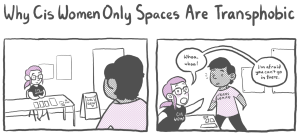Originally published on Adios Barbie and republished here with their permission.
For the first time in her life, my eight-year-old daughter is finally able to be her true self. She loves dresses, the color pink, and rocking purses with pizzazz. These may seem like normal things, but for my daughter, being able to showcase her identity publicly this way is brand-new.
My daughter is transgender.
You may recall from an earlier article I wrote that we initially used the term “gender variant” when describing my child’s identity. You see, this has been a journey, and it hasn’t always been easy. When Emery first started displaying “feminine” traits, I’ll admit, I was a little uncomfortable.
I’ve had to work hard to retrain my brain and undo the stereotypes and damaging notions society and the media have hammered into me. And while I was still working that out, labeling Emery’s identity as gender variance was a way to swallow what was happening with my child.
But this isn’t gender variance.
Janet Mock says that defining what it means to be transgender as “trapped in the wrong body” is victimizing and puts transgender folks in a position to be pitied. I agree, but I use this phrase because it’s how Emery has described her experience for years. She’s told me that she has felt like she’s a girl inside, or rather, in her heart.
But I think it’s important to discern that just because she has felt trapped, that doesn’t mean she thinks of herself as a victim. She is unapologetically herself and refuses to let anyone put her in a box.
When she talks about Happy meals at McDonald’s, she says she would like a “girl” toy, air quotations and all. Her comprehension of silly gender roles is so mature for such a young age. She’s going to be an amazing advocate for the cause one day, and I’m excited to see her progress.
My own progress in this journey has been significant as well. When we were using the term “gender variant,” Emery was allowed to dress as she wanted at home, but in public, she otherwise presented as a boy. She wore boy clothes to school and was referred to with male pronouns.
Emery has always been a happy child, but I could see the effects this caused. Pretending to be someone she wasn’t was draining her of her full potential. As soon as she got home, the clothes would immediately come off, and it was back to dress-up.
When I found out that Emery had been bullied daily – and considering the high trans suicide attempt rate – I knew something had to change, and I set to work.
First, I reached out to Emery’s school district and set up a meeting. While I was apprehensive at first, the supportive staff quickly reassured me. I was told that some of the staff had already been to a diversity training, and that they’d refer to Emery as “she” from here on out. She would have access to the counselor any time she needed it, and no one would know a thing about Emery’s identity unless she wanted it made known.
They said it would perhaps be best if she used the staff bathroom versus the girls’ or boys’ bathroom, and I agree this is a fine solution – for now. I do worry how we’ll handle this as Emery hits puberty, and how gym class will be dealt with. But we’ll cross that bridge when we get there.
We started meeting with a counselor on a regular basis to help Emery develop tactics for combatting bullying. She’s opened up to me much more and lets me in on her feelings, where before she was guarded over them.
We watch I Am Jazz on TLC every week together, and this show about the life of a transgender girl is so helpful – not just for me, but for her as well.
Since we don’t know any other transgender youth in our area, it’s important for Emery to see herself represented in the media. It helps bolster her identity and allows her to relate to someone like her, which she can really do with Jazz.
The media has a huge impact on the way society perceives identity, and providing accurate representations of trans folk will help us achieve more widespread acceptance.
While the media seems to be doing a better job of this, there’s still work to be done. Trans youth, people of color, and those who don’t fit the beauty standard established by our cis-centric society are noticeably lacking in the media.
The movie About Ray will be released this year and tells the story of a transgender teenager, but Ray is played by Elle Fanning, a cis white actress. The film Stonewall has been gaining momentum, but again, the actor playing the lead character who started it all is a cis white male. This doesn’t accurately depict the diverse group that’s credited with starting the revolution, with numerous trans women and people of color at the forefront.
And while I’m happy for Caitlyn Jenner and applaud her bravery for finally transitioning to the person she always was inside, it’s important to note that her story isn’t typical. Money, fame, race, and a socially acceptable level of attractiveness made this transition easier for her than for everyday trans people who may not have the money for a sex change or beauty products, or who don’t necessarily fit the beauty standards society mandates.
I’m glad we’re finally hearing more about LGBTQIA+ lives, but enough with the whitewashing and ciswashing, okay, Hollywood?
When Emery’s school started this year, I was a ball of nerves the entire day. She was fitted in a fun black dress with sparkly flats and was eager to go public for the first time ever.
When I finally got home from work that day, I was greeted with only enthusiasm and positivity. The kids were much more receptive than they were last year, and I think a lot of it has to do with the way Emery is now presenting herself.
As we continue to discuss these issues in the media and as society grows more accepting, it will be easier for more children (and adults) to feel like they can live their true, authentic selves. While we will certainly face hitches as Emery gets older, she’s truly happy now, and that is worth it all for me.
[do_widget id=’text-101′]
After recovering from an eating disorder, Tasha Sanders found inspiration through feminism and the body positivity movement. When she isn’t writing about female empowerment and social justice issues, she enjoys reading, baking, penning a novel, and spending time with her two children. Read more from Tasha on her blog, Feminine Feministe.
Search our 3000+ articles!
Read our articles about:
Our online racial justice training
Used by hundreds of universities, non-profits, and businesses.
Click to learn more





















